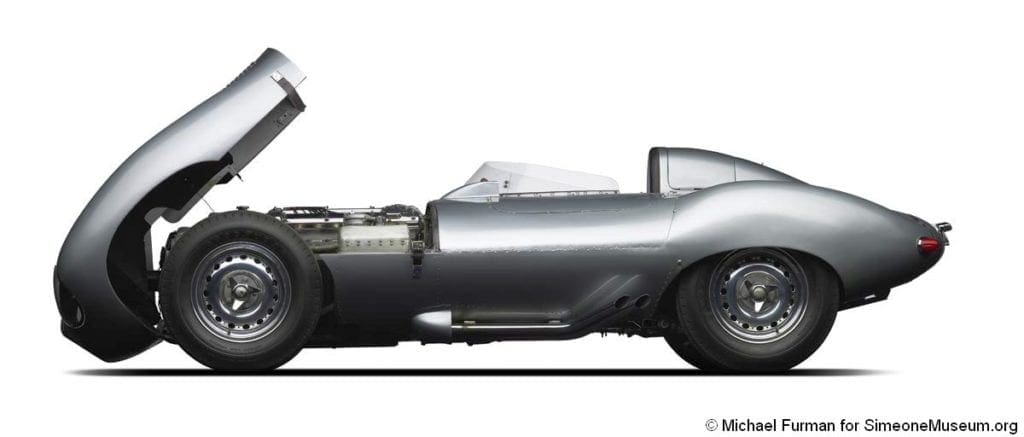Our car came in third in the 1956 Sebring 12 Hour race, driven by Juan Manuel Fangio. I later purchased it through an auction in 1984, with Mick Jagger as an underbidder.
THESE CARS
With the great success of the Jaguar C-types in racing, competition would push the evolutionary development further. This development had already been started and resulted in later cars introducing disc brakes. By the year1954, the unmarked prototypes were busy at work. For the first time, Jaguar made a monocoque chassis, with a subframe carrying the engine and the front suspension bolted on for easy disassembly. Basically, the same engine was now used in a d
They enhanced Malcolm Sayer’s new streamlined body with a large fin on the headrest for long-distance races, most notably Le Mans. This fin allegedly provided stability at speeds over 150 miles per hour. In 1954 they were no match for the 4.9 liter Ferrari 3.75MM plus, but the next year they handily won against competition from the great Mercedes-Benz SLR (a race which the German team abandoned when one of their cars crashed into the crowd). In 1956 they were again successful. During its development, the 3 Weber, 9.0:1 compression engine, with the ever constant 3442 cc displacement, reached 250hp @ 5750RPM, but by 1957 Jaguar quit racing.
OUR CAR
This car had been originally supplied to the Jaguar Midwest Distributors Inc. in Indianapolis, and later sold to Jack Ensley, president of the company. Its auspicious start was the 1956 Sebring 12-hour race, where Bob Sweikert and Ensley brought it to third place. More about Mr. Sweikert later. Later it raced in St. Louis, the Wisconsin Grand Prix, and the C-modified British Grand Prix at Silverstone, where it had a minor incident rebuilt at the factory. It came in second in the 1957 Watkins Glen Grand Prix, and afterwards sold to Barney Devlin, who then sold it to collector Harry Heinl, who kept it for several years, passing it on to Preston Smith, who finally offered it for sale through the Vintage Car Store.
We purchased it in 1984 in an mostly original condition, except for a Jaguar silver repaint, but otherwise intact down to the original trim. Someone added some Stewart-Warner additional gauges, and we left them in place. The car has always been a wonderful performer. The most startling feature, besides the smooth acceleration, is the very early uses of disc brakes in a race car which added to its racing performance.
Bob Sweikert is a somewhat forgotten racing hero whose tragic death at age 30 cheated us of greater adventures. Proficient with many race cars, he raced regularly and his greatest achievement was winning the 1955 Indianapolis race. After coming in third place at Sebring, his next race was a sprint event in Salem, Indiana, where his car went off the side, burst into flames, and tragically killed. At that race was his wife, a childhood sweetheart and loving companion, Dori, who later memorialized their life together in her book “Along for the Ride–A Love Story.” She writes: “Bob was the first Speedway driver to take part in the annual sports car competition at Sebring and quoted by the press as saying he’d have to learn to drive all over again. Juan Fangio, the Argentine Grand Prix world champion found time to take Bob over the 5.2 mile road course give him some pointers on the light foot handling and brakes and accelerator of that a sports car [our D-type–FAS] racing demanded. After driving a calculated conservative six hours in fifth and sixth place he came in and turned the cockpit over to Jack Ensley. Two hours later he resumed the driving waiting until the race was in its last two hours to make his move. At the end of the 12 hours he finished in third place, surprising the skeptics who said he would fail. The sports car world and some of the press applauded him for his achievement but accolades that meant most to him came from Fangio. Invitations were exchanged from Fangio to Bob to further explore sports car racing in Europe and Bob to Fangio to come to the speedway.”
It is noteworthy that in 1955 the Automobile Association of America, which sanctioned all major races since 1904, abrogated this activity because they felt the races had become too dangerous. It was at this point that the United States Auto Club (USAC) took over racing. In fact, the analysis of the race drivers in the 1955 Indianapolis, the one that Sweikert won and the AAA later abandoned, showed that of the 33 qualifiers, 17 later died in race cars! These included such greats as Bill Vukovich and Tony Bettenhausen. It pays to pause and ponder about the sport we love.

Vintage car store salesman Victor Forte recalls that Mick Jagger was the underbidder, and was miffed when he didn’t get no satisfaction.
Fred Simeone













